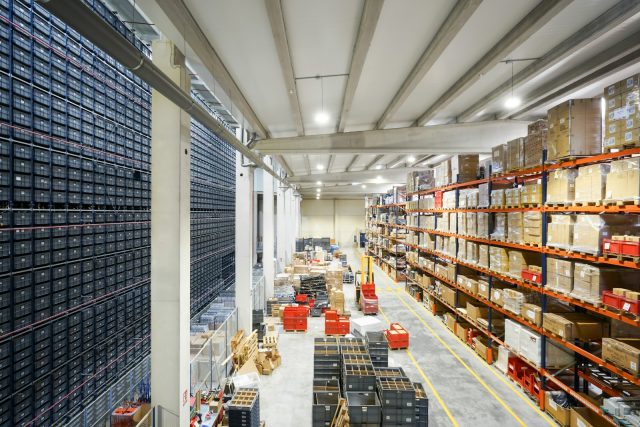
Imagine this. Your online store is booming. Orders fly in before your coffee even cools, customers refresh their inboxes like it’s a sport, and suddenly you’re standing in the middle of a living room that looks more like a cardboard jungle than a home. Exciting? Sure. Sustainable? Not unless you love tripping over bubble wrap at 2 a.m.
That’s the moment an ecommerce warehouse quietly steps in to rescue your sanity. It’s not just a massive space stacked with shelves and forklifts. It’s the heartbeat of modern online shopping, the backstage crew that makes sure sneakers land on sneakerheads’ doorsteps, skincare shows up before breakouts hit, and holiday gifts don’t miss the actual holiday.
Without it, chaos. With it, smooth scaling.
So, What’s an Ecommerce Warehouse Anyway?
On paper, it’s a building where products hang out until someone buys them. In reality? It’s way more impressive.
Think of it as a mash-up of logistics, technology, and organization that would make Marie Kondo weep with joy. Everything has its place. Orders zip through scanners, workers move with muscle memory, and boxes practically sprint out the door. It’s like a symphony of shipping labels and tape guns, minus the tuxedos.
And because online shopping never sleeps, these warehouses are wired for speed.
Why Ecommerce Warehouses Run the Show
Every time you click “buy now,” you set off a chain reaction. You expect fast, maybe free shipping. You don’t care that it takes dozens of moving parts to make that happen. You just want the package at your door, preferably yesterday.
That “no-drama” experience? It lives and dies inside an ecommerce warehouse. They keep inventory neat, orders flying out, and customers happy enough to leave reviews instead of rants.
McKinsey found that distributors who improved operations since 2019 boosted returns on invested capital by almost 30%, among other gains. That’s not a small perk. That’s the kind of number that makes accountants smile and founders sleep at night.
The Tech Toys Behind It All
Forget dusty clipboards. Today’s ecommerce warehouses are high-tech playgrounds.
- Warehouse management systems: Software that stalks inventory so you don’t have to.
- Barcode and RFID scanning: No more guessing games. Every item gets tracked.
- Robotics: Machines that don’t complain about back pain or take snack breaks.
- AI forecasting: Predicts how much stock you’ll actually need, so you’re not sitting on 5,000 unsold glow-in-the-dark fanny packs.
The mix of human skill and machine efficiency keeps the whole operation running like clockwork.
Location Still Matters
Shipping times aren’t magic. They’re geography. A warehouse next to major shipping hubs or big cities can shave days off delivery. That’s not just convenience, that’s loyalty-building.
Capital One reports that American consumers (41%) are willing to pay more for same-day delivery of their retail orders. Translation: if you’re slow, someone else gets their money.
People Still Run the Show
Sure, robots look cool, but people still make warehouses work. Forklift drivers who could thread a needle with a pallet. Packers who nail the art of fitting five oddly-shaped items into one box without breaking a sweat.
They’re the reason your candle set doesn’t show up looking like a melted disaster.
Ecommerce Warehouse vs. The Old School Kind
Here’s the difference. A traditional warehouse is all about bulk. Big shipments to retail stores, stacked pallets, forklifts moving tons at once.
An ecommerce warehouse? It’s obsessed with individual orders. Smaller packages, faster turnaround, customized touches. Basically, built for people who want their orders now, not next quarter.
When the Garage Isn’t Cutting It
Every small brand hits the wall eventually. At first, it’s fun. Orders trickle in, and packing them yourself feels personal. Then… the avalanche hits.
Suddenly, you’re knee-deep in packing tape, shipping labels are your worst enemy, and your living room looks like a discount UPS store. Customers get impatient. Orders slip through the cracks. You’re burning out.
That’s the neon sign flashing: “You need an ecommerce warehouse.”
How Warehouses Shape the Customer Experience
Here’s the truth. Customers don’t separate the product from the delivery. A late package feels like a bad product. A broken box feels like the brand doesn’t care.
Warehouses make sure that doesn’t happen. On-time shipments equal repeat buyers. Smooth packaging equals five-star reviews. Basically, the warehouse becomes the silent hero of customer service.
The Return Game Nobody Likes
Returns are inevitable. In fact, Shopify reports the average ecommerce return rate was 16.9% in 2024, with many retailers seeing return rates up toward 20-30%.
A smart ecommerce warehouse handles returns like a pro. Fast inspections, quick restocks, minimal drama. It’s not glamorous, but it keeps customers from bolting to a competitor.
Let’s Talk Money
Running a warehouse costs money. But trying to do it all yourself usually costs more.
Think of lost sales from missed orders, refund requests, or bad reviews. The right ecommerce warehouse cuts those risks. It’s not just about expense, it’s about growth.
Signs It’s Time to Upgrade
Still convincing yourself you’re fine? Check these symptoms:
- Your house is drowning in cardboard.
- Customers are asking, “Where’s my stuff?” more than once.
- You spend more time with a tape gun than your laptop.
- Spreadsheets are starting to haunt your dreams.
If you nodded at any of those, it’s time.
Picking the Right Partner
Not every warehouse is a good match. The right one should be transparent on costs, tech-savvy, easy to use, strategically located, and flexible enough to scale with you.
One strong option is ShipBots, an ecommerce warehouse built for online brands that need speed without the chaos. They’ve nailed the balance between tech, accuracy, and growth.
The Green Angle
Customers care about the planet now, and warehouses are catching up. The best ones use recycled packaging, energy-efficient systems, and smarter shipping routes.
Nearly 80% of shoppers say sustainability influences their shopping decisions (Mckinsey). Ignore that, and you risk losing them before checkout.
What’s Coming Next
Warehouses aren’t done evolving. Expect:
- More robots (the non-scary kind).
- AI predicting stock better than fortune tellers.
- Augmented reality tools so workers find items faster.
- Micro-warehouses in cities for lightning-fast delivery.
The warehouse of tomorrow won’t just store boxes. It’ll think, adapt, and move faster than ever.
The Bottom Line
Ecommerce isn’t slowing down, and fulfillment is where brands sink or swim. The right ecommerce warehouse keeps orders clean, customers happy, and businesses focused on growth instead of drowning in packaging tape.
So the next time you get a perfectly-timed delivery, give a nod to the warehouse behind it. Because without it? Your online shopping habit would be a whole lot messier.








